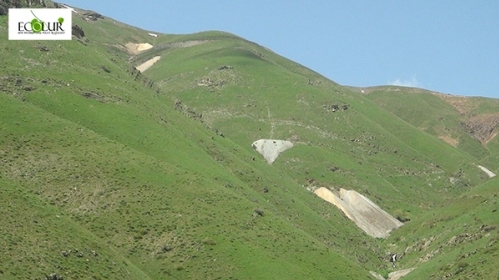

EcoLur
Gladzor and Vernashen residents, Vayots Dzor Region, assess risks for their health to be caused with Gladzor poly-metallic mining as extremely high. Gladzor mine is intended to be developed by Vayq Metal Company. The first project was issued a negative opinion by Environmental Expertise of RA Nature Protection Ministry in 2016. Nevertheless, on 18 July 2017 the representatives of this company held a meeting with the villagers of both villages in order to get their consent to a new project on Gladzor mining. The company didn't inform about any probable risks for health and environment. The villagers applied to EcoLur to receive available information on the probable impact of the metals contained in the ore on their health. Hrachya Avagyan, Chief Specialist at the Institute of Economics of NAS RA, Dr in Geological Sciences, writes in his book by entitled “Ways and Prospects of Mining and Metallurgical Industries in the Republic of Armenia” (Yerevan 2011, “Gitutyun” Publishing House, Institute of Economics of NAS RA) that the largest share in Gladzor mine ore vests on lead. According to the predicted data only, the mine contains 861.5 thousand tons of lead. The ore also has high concentrations of sulfur – 3405500 tons. Sulfur has also a dangerous aspect for health, as it simultaneously forms compounds, which promote activation of chemical processes connected with heavy metals and their penetration into the environment.
Unfortunately, RA Nature Protection Ministry doesn't deal with the assessment of the impact of negative factors in the environment on human health, while the specialized institute of professional diseases has actually been destroyed. Moreover, the departments of Health Ministry refuse to provide statistical data on the repetitive diseases to determine the geography of the spread of these diseases. In the frames of these opportunities, this function is partially performed by research organizations. Below we bring the data of individual researchers on the assessment of risks for health carried out by the American University of Armenia:
1. “Akhtala Pilot Project on Community Empowerment Final Report”, 2014.
This research particularly says: “Thorough assessment of risk and level of lead in blood is needed... Encourage the residents of Akhtala to use only heavy metal-free areas in the community as crop cultivation and animal grazing land. …Provide healthy nutrition to school and kindergarten children in Akhtala to reduce heavy metal poisoning....'.
2. “Lead exposure and measure of IQ level among children in Alaverdi, Akhtala and Yerevan”, Research project by Siran Grboyan.
This research particularly says: 'The Environmental Protection Agency (EPA) classifies lead compounds as probable human carcinogens. Some studies show the relationship between lead exposure and cancers of the lung, stomach, brain, kidney, bladder, colon and rectum. However, these studies did not take into consideration other risk factors. Studies in lab animals show links between lead exposure cancer; in particular, large doses of lead can cause kidney tumors in rats and mice. People, who live near hazardous areas, can be exposed to lead by breathing air, drinking water, eating food, or swallowing dust or dirt contaminated with lead. Drinking lead contaminated water or ingesting lead-containing dust or soil can be the reasons for children’s exposure to lead. Infants and young children are particularly sensitive to ingestions of soil/dust because of hand-to-mouth activities and physiological factors (e.g., poorly developed blood brain barrier). Pregnant women are also considered vulnerable due to exposure of the developing fetus.'
The specialists of the AUA also researched in the frames of in the Armenia Demographic and Health Survey (ADHS) that the percentage of pregnancies having ended up with miscarriages made up 14% in Lori Region in 2010. This is the highest indicator in Armenia, almost twice as high as the average figure in Armenia. The studies show that the women of reproductive age living in Alaverdi have higher risks of reproductive health problems than women living in Artik where there is no mining. The women living in Alaverdi have 2.38% of higher chances to have stillborn children and 2.67% higher chances to have induced abortion according to medical indicators than in Artik.
According to McMichael et al., 1986; Wulff Marianne et al., 1995, the cities with ore smelting factories have higher risks of stillbirth and perinatal mortality, which is related to the emissions of heavy metals and sulfur dioxide into the environment.
The research paper authored by Ruzanna Grigoryan, Varduhi Petrosyan and Tsovinar Melkumyan entitled 'Risk Factors for Childen with Lead Level in Blood in Mining and Metallurgical Communities in Armenia' says, 'With average level of 6.0 mkg/dl lead in blood, the level of lead in the blood samples from children in Akhtala made up 6.8, 6.4 in Alaverdi and 5.1 in Yerevan. The research shows that the children from the communities adjacent to the mining industry are exposed to lead impact.'
4. The mass media also published information on the impact of heavy metals in health in those areas, where there is the high level of metallic pollution because of mining activities. Thus, on 30 November 2012, the “Syunyats Yerkir” published the editorial by Samvel Aleksanyan “Increase and Spread of Several Diseases in Kapan and Meghri Reached Threatening Ranges.” The article particularly says: “The increase in diseases due to poor ecology still continues in Kapan. Within last three years the number of people newly suffering from cardiovascular diseases, as well as cancer and endocrine diseases has increased by three times. The number of people having received a category of disability has also increased, and now the number of disabled people makes up 10% of Kapan population. Birth rate also decreases. If in 2008 this indicator made up 9.2 per thousand, in 2011 – 8.3 per thousand as compared with average indicator for Syunik Region – 11.2 per thousand…”
July 31, 2017 at 18:27
